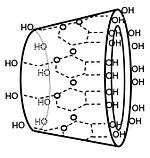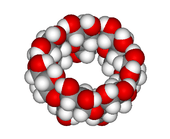Cyclodextrin
Cyclodextrins are a family of cyclic oligosaccharides, consisting of a macrocyclic ring of glucose subunits joined by α-1,4 glycosidic bonds. Cyclodextrins are produced from starch by enzymatic conversion. They are used in food, pharmaceutical, drug delivery, and chemical industries, as well as agriculture and environmental engineering.[1]

Cyclodextrins are composed of 5 or more α-D-glucopyranoside units linked 1->4, as in amylose (a fragment of starch). The largest cyclodextrin contains 32 1,4-anhydroglucopyranoside units, while as a poorly characterized mixture, at least 150-membered cyclic oligosaccharides are also known. Typical cyclodextrins contain a number of glucose monomers ranging from six to eight units in a ring, creating a cone shape:
- α (alpha)-cyclodextrin: 6 glucose subunits
- β (beta)-cyclodextrin: 7 glucose subunits
- γ (gamma)-cyclodextrin: 8 glucose subunits
Applications
Drug delivery
With a hydrophobic interior and hydrophilic exterior, cyclodextrins form complexes with hydrophobic compounds. Alpha-, beta-, and gamma-cyclodextrin are all generally recognized as safe by the U.S. FDA.[2][3] They have been applied for delivery of a variety of drugs, including hydrocortisone, prostaglandin, nitroglycerin, itraconazol, chloramphenicol. The cyclodextrin confers solubility and stability to these drugs.[1] The inclusion compounds of cyclodextrins with hydrophobic molecules are able to penetrate body tissues, these can be used to release biologically active compounds under specific conditions.[4] In most cases the mechanism of controlled degradation of such complexes is based on pH change of water solutions, leading to the loss of hydrogen or ionic bonds between the host and the guest molecules. Alternative means for the disruption of the complexes take advantage of heating or action of enzymes able to cleave α-1,4 linkages between glucose monomers. Cyclodextrins were also shown to enhance mucosal penetration of drugs.[5]
Other
Cyclodextrins bind fragrances. Such devices are capable of releasing fragrances during ironing or when heated by human body. Such a device commonly used is a typical 'dryer sheet'. The heat from a clothes dryer releases the fragrance into the clothing. They are the main ingredient in Febreze which claims that the β-cyclodextrins "trap" odor causing compounds, thereby reducing the odor.[1]
Cyclodextrins are also used to produce alcohol powder by encapsulating ethanol. The powder produces an alcoholic beverage when mixed with water.
Structure

Typical cyclodextrins are constituted by 6-8 glucopyranoside units. These subunits are linked by 1,4 glycosidic bonds. The cyclodextrins have toroidal shapes, with the larger and the smaller openings of the toroid exposing to the solvent secondary and primary hydroxyl groups respectively. Because of this arrangement, the interior of the toroids is not hydrophobic, but considerably less hydrophilic than the aqueous environment and thus able to host other hydrophobic molecules. In contrast, the exterior is sufficiently hydrophilic to impart cyclodextrins (or their complexes) water solubility. They are not soluble in typical organic solvents.
Synthesis
Cyclodextrins are prepared by enzymatic treatment of starch.[7][8] Commonly cyclodextrin glycosyltransferase (CGTase) is employed along with α-amylase. First starch is liquified either by heat treatment or using α-amylase, then CGTase is added for the enzymatic conversion. CGTases produce mixtures of cyclodextrins, thus the product of the conversion results in a mixture of the three main types of cyclic molecules, in ratios that are strictly dependent on the enzyme used: each CGTase has its own characteristic α:β:γ synthesis ratio. Purification of the three types of cyclodextrins takes advantage of the different water solubility of the molecules: β-CD which is poorly water-soluble (18.5 g/l or 16.3mM) (at 25C) can be easily retrieved through crystallization while the more soluble α- and γ-CDs (145 and 232 g/l respectively) are usually purified by means of expensive and time consuming chromatography techniques. As an alternative a "complexing agent" can be added during the enzymatic conversion step: such agents (usually organic solvents like toluene, acetone or ethanol) form a complex with the desired cyclodextrin which subsequently precipitates. The complex formation drives the conversion of starch towards the synthesis of the precipitated cyclodextrin, thus enriching its content in the final mixture of products. Wacker Chemie AG uses dedicated enzymes, that can produce alpha-, beta- or gamma-cyclodextrin specifically. This is very valuable especially for the food industry, as only alpha- and gamma-cyclodextrin can be consumed without a daily intake limit.

Derivatives
Interest in cyclodextrins is enhanced because their host–guest behavior can be manipulated by chemical modification of the hydroxyl groups. O-Methylation and acetylation are typical conversions. Propylene oxide gives hydroxypropylated derivatives.[1] The primary alcohols can be tosylated. The degree of derivatization is an adjustable, i.e. full methylation vs partial.[10]
Both β-cyclodextrin and methyl-β-cyclodextrin (MβCD) remove cholesterol from cultured cells. The methylated form MβCD was found to be more efficient than β-cyclodextrin. The water-soluble MβCD is known to form soluble inclusion complexes with cholesterol, thereby enhancing its solubility in aqueous solution. MβCD is employed for the preparation of cholesterol-free products: the bulky and hydrophobic cholesterol molecule is easily lodged inside cyclodextrin rings. MβCD is also employed in research to disrupt lipid rafts by removing cholesterol from membranes.[11]
Research
In supramolecular chemistry, cyclodextrins are precursors to mechanically interlocked molecular architectures, such as rotaxanes and catenanes. Illustrative, α-cyclodextrin form second-sphere coordination complex with tetrabromoaurate anion ([AuBr4]-).[12]
Beta-cyclodextrin complexes with certain carotenoid food colorants have been shown to intensify color, increase water solubility and improve light stability.[13][14]
History

Cyclodextrins, as they are known today, were called "cellulosine" when first described by A. Villiers in 1891.[15] Soon after, F. Schardinger identified the three naturally occurring cyclodextrins -α, -β, and -γ. These compounds were therefore referred to as "Schardinger sugars". For 25 years, between 1911 and 1935, Pringsheim in Germany was the leading researcher in this area, demonstrating that cyclodextrins formed stable aqueous complexes with many other chemicals. By the mid-1970s, each of the natural cyclodextrins had been structurally and chemically characterized and many more complexes had been studied. Since the 1970s, extensive work has been conducted by Szejtli and others exploring encapsulation by cyclodextrins and their derivatives for industrial and pharmacologic applications.[16] Among the processes used for complexation, the kneading process seems to be one of the best.[17]
Safety
Cyclodextrins are of wide interest in part because they are nontoxic. The LD50 (oral, rats) is on the order of grams per kilogram.[1] Nevertheless, attempts to use cyclodextrins for the prevention of atherosclerosis[18], age-related lipofuscin accumulation[19] and obesity encounter an obstacle in the form of damage to the auditory nerve[20] and nephrotoxic effect[21]
References
- Thomas Wimmer (2012). "Cyclodextrins". Ullmann's Encyclopedia of Industrial Chemistry. Wiley-VCH. doi:10.1002/14356007.e08_e02. ISBN 978-3527306732.CS1 maint: uses authors parameter (link)
- GRAS Notice No. GRN 000155, alpha-cyclodextrin;GRAS Notice No. GRN 000074, beta-cyclodextrin;GRAS Notice No. GRN 000046, gamma-cyclodextrin
- Uekama, Kaneto; Hirayama, Fumitoshi; Irie, Tetsumi (1998). "Cyclodextrin Drug Carrier Systems". Chemical Reviews. 98 (5): 2045–2076. doi:10.1021/CR970025P. PMID 11848959.CS1 maint: uses authors parameter (link)
- Becket, Gordon; Schep, Leo J.; Tan, Mun Yee (1999). "Improvement of the in vitro dissolution of praziquantel by complexation with α-, β- and γ-cyclodextrins". International Journal of Pharmaceutics. 179 (1): 65–71. doi:10.1016/S0378-5173(98)00382-2. PMID 10053203.
- Morrison, Peter W. J.; Connon, Che J.; Khutoryanskiy, Vitaliy V. (2013-01-18). "Cyclodextrin-Mediated Enhancement of Riboflavin Solubility and Corneal Permeability" (PDF). Molecular Pharmaceutics. 10 (2): 756–762. doi:10.1021/mp3005963. ISSN 1543-8384. PMID 23294178.
- Motoyama, Akira; Suzuki, Ayako; Shirota, Osamu; Namba, Ryujiro (2002). "Direct determination of pindolol enantiomers in human serum by column-switching LC-MS/MS using a phenylcarbamate-β-cyclodextrin chiral column". Journal of Pharmaceutical and Biomedical Analysis. 28 (1): 97–106. doi:10.1016/S0731-7085(01)00631-8. PMID 11861113.
- József Szejtli (1998). "Introduction and General Overview of Cyclodextrin Chemistry". Chem. Rev. 98 (5): 1743–1754. doi:10.1021/cr970022c. PMID 11848947.
- Biwer, A.; Antranikian, G.; Heinzle, E. (2002). "Enzymatic production of cyclodextrins". Applied Microbiology and Biotechnology. 59 (6): 609–17. doi:10.1007/s00253-002-1057-x. PMID 12226716.
- Stanier, Carol A.; O'Connell, Michael J.; Anderson, Harry L.; Clegg, William (2001). "Synthesis of fluorescent stilbene and tolan rotaxanes by Suzuki coupling". Chemical Communications (5): 493–494. doi:10.1039/b010015n.
- Bernadette Brady, Nuala Lynam, Thomas O'Sullivan, Cormac Ahern, Raphael Darcy (2000). "6A-O-p-Toluenesulfonyl-β-Cyclodextrin". Org. Synth. 77: 220. doi:10.15227/orgsyn.077.0220.CS1 maint: uses authors parameter (link)
- Rodal, Siv Kjersti; Skretting, Grethe; Garred, Øystein; Vilhardt, Frederik; van Deurs, Bo; Sandvig, Kirsten (1999). "Extraction of Cholesterol with Methyl-β-Cyclodextrin Perturbs Formation of Clathrin-coated Endocytic Vesicles". Molecular Biology of the Cell. 10 (4): 961–74. doi:10.1091/mbc.10.4.961. PMC 25220. PMID 10198050.
- Liu, Zhichang; Frasconi, Marco; Lei, Juying; Brown, Zachary J.; Zhu, Zhixue; Cao, Dennis; Iehl, Julien; Liu, Guoliang; Fahrenbach, Albert C.; Botros, Youssry Y.; Farha, Omar K.; Hupp, Joseph T.; Mirkin, Chad A.; Stoddart, J. Fraser (2013). "Selective isolation of gold facilitated by second-sphere coordination with α-cyclodextrin". Nature Communications. 4: 1855. Bibcode:2013NatCo...4.1855L. doi:10.1038/ncomms2891. PMC 3674257. PMID 23673640.
- Marcolino, Vanessa Aparecida; Zanin, Gisella Maria; Durrant, Lucia Regina; Benassi, Marta De Toledo; Matioli, Graciette (2011). "Interaction of Curcumin and Bixin with β-Cyclodextrin: Complexation Methods, Stability, and Applications in Food". Journal of Agricultural and Food Chemistry. 59 (7): 3348–57. doi:10.1021/jf104223k. PMID 21381747.
- De Oliveira, Vanessa E.; Almeida, Eduardo W. C.; Castro, Harlem V.; Edwards, Howell G. M.; Dos Santos, Hélio F.; De Oliveira, Luiz Fernando C. (2011). "Carotenoids and β-Cyclodextrin Inclusion Complexes: Raman Spectroscopy and Theoretical Investigation". The Journal of Physical Chemistry A. 115 (30): 8511–9. Bibcode:2011JPCA..115.8511D. doi:10.1021/jp2028142. PMID 21728366.
- Villiers, A. "Sur la transformation de la fécule en dextrine par le ferment butyrique". Compt. Rend. Acad. Sci. 1891: 536–8.
- Szejtli J. (1988). "Cyclodextrin Technology" vol 1. Springer, New York" ISBN 978-90-277-2314-7
- Gil, A.; Chamayou, A.; Leverd, E.; Bougaret, J.; Baron, M.; Couarraze, G. (2004). "Evolution of the interaction of a new chemical entity, eflucimibe, with γ-cyclodextrin during kneading process" (PDF). European Journal of Pharmaceutical Sciences. 23 (2): 123–9. doi:10.1016/j.ejps.2004.06.002. PMID 15451000.
- Sebastian Zimmer, Alena Grebe, Siril S. Bakke et al., and Eicke Latz (2016). Cyclodextrin promotes atherosclerosis regression via macrophage reprogramming. Science Translational Medicine: 8(333), 333ra50 doi:10.1126/scitranslmed.aad6100
- Gaspar, J., Mathieu, J., & Alvarez, P. (2017). 2-Hydroxypropyl-beta-cyclodextrin (HPβCD) reduces age-related lipofuscin accumulation through a cholesterol-associated pathway. Scientific reports, 7(1), 2197. PMC 5438378
- Crumling MA, Liu L, Thomas PV, Benson J, Kanicki A, Kabara L, et al. (2012) Hearing Loss and Hair Cell Death in Mice Given the Cholesterol-Chelating Agent Hydroxypropyl-β-Cyclodextrin. PLoS ONE 7(12): e53280. doi:10.1371/journal.pone.0053280
- Scantlebery, A.M.L., Ochodnicky, P., Kors, L. et al. (2019). β-Cyclodextrin counteracts obesity in Western diet-fed mice but elicits a nephrotoxic effect. Sci Rep 9, 17633 doi:10.1038/s41598-019-53890-z